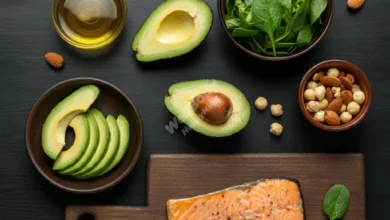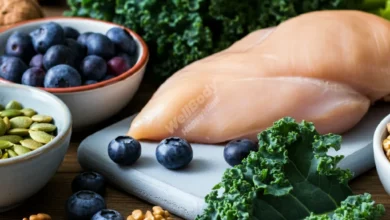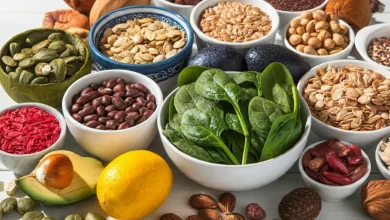Superfoods for Weight Loss: Nature’s Secret Weapon

I. Introduction
Did you know that some foods are so packed with nutrients that they’ve earned the title of “superfoods”? These nutritional powerhouses have been making waves in the health and wellness world, and for good reason. But here’s an exciting twist: certain superfoods might just be your secret weapon in the battle against stubborn pounds!
In this post, we’ll dive into the world of superfoods for weight loss and explore how these nutrient-dense wonders can support your weight management goals. Get ready to discover how nature’s finest can help you on your journey to a healthier, happier you!
II. Understanding Superfoods
A. What makes a food “super”?
Superfoods are nutrient-rich foods that offer exceptional health benefits. These foods pack a powerful punch of vitamins, minerals, antioxidants, and other beneficial compounds in relatively small portions. While there’s no official scientific definition, the term “superfood” generally refers to foods that provide more nutrients per calorie than most other foods.
B. Key characteristics of superfoods
- High in essential nutrients
- Rich in antioxidants
- Often plant-based, but can include some animal products
- Usually low in calories
- Contain healthy fats
- High in fiber
- Offer multiple health benefits
C. Common misconceptions about superfoods
It’s important to understand that superfoods aren’t magical cure-alls. While they can significantly contribute to a healthy diet, they won’t cancel out poor eating habits or instantly melt away excess weight. The impact of superfoods on weight management is most effective when they’re part of a balanced diet and healthy lifestyle.
III. How Superfoods Support Weight Loss
A. Nutrient density
Nutrient density refers to the amount of beneficial nutrients a food provides relative to its calorie content. Superfoods are typically very nutrient-dense, meaning they pack a lot of nutritional value into a small number of calories.
For weight loss, this is crucial because nutrient-dense foods help you feel satisfied while consuming fewer calories. They provide your body with essential nutrients, reducing cravings and the likelihood of overeating.
B. Fiber content
Many superfoods are rich in fiber, which plays a vital role in weight management:
- Promotes feelings of fullness
- Slows digestion, helping to stabilize blood sugar levels
- Supports healthy gut bacteria
Examples of high-fiber superfoods include:
- Chia seeds
- Berries
- Leafy greens
- Lentils
C. Metabolism boosting properties
Some superfoods may help increase your metabolism, the rate at which your body burns calories. For instance:
- Green tea contains compounds that may slightly boost metabolic rate
- Chili peppers have capsaicin, which can increase calorie burning
- Protein-rich superfoods like quinoa or salmon can increase the thermic effect of food (calories burned during digestion)
While these effects are generally modest, they can contribute to your overall weight loss efforts when combined with a healthy diet and exercise.
D. Satiety and appetite control
Certain superfoods can help you feel full and satisfied, reducing overall calorie intake. Examples include:
- Avocados: Rich in healthy fats and fiber
- Greek yogurt: High in protein, which promotes fullness
- Apples: Contain pectin, a type of fiber that can suppress appetite
- Oatmeal: Provides slow-releasing energy, keeping you full longer
By incorporating these superfoods for weight loss into your meals, you may find it easier to control your appetite and stick to your weight management goals.

IV. Top Superfoods for Weight Loss
A. Leafy greens (e.g., kale, spinach)
Nutritional benefits:
- High in vitamins A, C, and K
- Rich in antioxidants
- Low in calories
How it supports weight loss:
Leafy greens are extremely low in calories but high in volume, helping you feel full without consuming excess calories.
Suggested ways to incorporate:
- Add to smoothies
- Use as a base for salads
- Sauté as a side dish
- Include in soups and stews
B. Berries (e.g., blueberries, acai)
Nutritional benefits:
- High in antioxidants
- Good source of fiber
- Low in calories
How it supports weight loss:
Berries are naturally sweet but low in calories, making them a great alternative to high-calorie desserts.
Suggested ways to incorporate:
- Top yogurt or oatmeal
- Add to smoothies
- Eat as a snack
- Use in healthy baked goods
C. Nuts and seeds (e.g., almonds, chia seeds)
Nutritional benefits:
- High in healthy fats
- Good source of protein
- Rich in fiber
How it supports weight loss:
Despite being calorie-dense, nuts and seeds can help with weight loss by promoting feelings of fullness and reducing overall calorie intake.
Suggested ways to incorporate:
- Use as a topping for salads or yogurt
- Enjoy as a snack
- Add to smoothies or oatmeal
- Use in homemade energy bars
D. Fatty fish (e.g., salmon, mackerel)
Nutritional benefits:
- High in omega-3 fatty acids
- Excellent source of protein
- Rich in vitamin D
How it supports weight loss:
The high protein content helps build lean muscle mass and boosts metabolism.
Suggested ways to incorporate:
- Grill or bake for a main dish
- Add to salads
- Use in fish tacos
- Make fish cakes
E. Whole grains (e.g., quinoa, oats)
Nutritional benefits:
- High in fiber
- Good source of B vitamins
- Contain essential minerals
How it supports weight loss:
Whole grains provide sustained energy and help you feel full for longer periods.
Suggested ways to incorporate:
- Use as a base for grain bowls
- Add to soups and salads
- Enjoy as a hot breakfast cereal
- Use in place of refined grains in recipes
F. Legumes (e.g., lentils, chickpeas)
Nutritional benefits:
- High in protein and fiber
- Rich in vitamins and minerals
- Low in fat
How it supports weight loss:
The combination of protein and fiber in legumes promotes satiety and helps stabilize blood sugar levels.
Suggested ways to incorporate:
- Add to soups and stews
- Use in salads
- Make homemade hummus
- Use in veggie burgers
G. Green tea
Nutritional benefits:
- Contains catechins (antioxidants)
- Has a small amount of caffeine
- Zero calories when unsweetened
How it supports weight loss:
Green tea may slightly boost metabolism and increase fat burning, especially when combined with exercise.
Suggested ways to incorporate:
- Drink hot or iced
- Use as a base for smoothies
- Cook grains in green tea instead of water
- Use in marinades or sauces

V. Incorporating Superfoods into Your Diet
A. Meal planning with superfoods
- Start small: Introduce one or two superfoods at a time to avoid overwhelming yourself.
- Replace, don’t add: Swap out less nutritious foods with superfoods rather than simply adding them to your current diet.
- Plan ahead: Prepare superfood-rich meals in advance to ensure you always have healthy options on hand.
- Mix and match: Combine different superfoods to create nutrient-packed meals.
- Be creative: Experiment with new recipes to keep your meals interesting and enjoyable.
B. Superfood smoothie recipes
Green Goddess Smoothie
- 1 cup spinach
- 1/2 avocado
- 1 banana
- 1 tbsp chia seeds
- 1 cup almond milk
- 1 tsp honey (optional)
Berry Blast Smoothie
- 1 cup mixed berries
- 1/2 cup Greek yogurt
- 1 tbsp almond butter
- 1 cup unsweetened green tea (cooled)
- 1 handful of kale
Tropical Superfood Smoothie
- 1/2 cup pineapple chunks
- 1/2 banana
- 1 tbsp coconut oil
- 1 cup coconut water
- 1 tbsp hemp seeds
- 1 handful of spinach
C. Superfood snack ideas
- Apple slices with almond butter and chia seeds
- Greek yogurt topped with mixed berries and a drizzle of honey
- Homemade trail mix with nuts, seeds, and dried goji berries
- Kale chips seasoned with nutritional yeast
- Roasted chickpeas with spices
- Avocado toast on whole grain bread with a sprinkle of hemp seeds
D. Balancing superfoods with other foods
While superfoods are incredibly nutritious, it’s important to maintain a balanced diet. Superfoods should complement, not replace, other healthy foods. Aim to include a variety of fruits, vegetables, lean proteins, and whole grains in your meals alongside superfoods.
Remember, the key to successful weight management is creating a sustainable eating plan. Incorporate superfoods in a way that fits your lifestyle and preferences. This approach ensures you’re getting a wide range of nutrients while also enjoying your meals.

VI. Potential Pitfalls to Avoid
A. Overconsumption of calorie-dense superfoods
While superfoods are packed with nutrients, some can also be high in calories. Examples of high-calorie superfoods include:
- Nuts and seeds
- Avocados
- Coconut oil
- Dried fruits
Importance of portion control:
Even with superfoods, calories matter for weight loss. It’s crucial to be mindful of portion sizes, especially with calorie-dense options. For instance, while nuts are nutritious, a small handful (about 1 ounce) is typically an appropriate serving size.
B. Relying solely on superfoods for weight loss
Superfoods can significantly contribute to weight loss, but they’re not a magic solution. A balanced approach is necessary for sustainable weight management:
- Varied diet: Include a wide range of foods, not just superfoods, to ensure you’re getting all necessary nutrients.
- Calorie balance: Remember that weight loss ultimately depends on creating a calorie deficit.
- Physical activity: Regular exercise is crucial for overall health and weight management.
- Lifestyle factors: Adequate sleep, stress management, and hydration all play important roles in weight loss.
- Consistency: Sustainable weight loss comes from long-term healthy habits, not short-term “superfood diets.”
While superfoods can boost the nutritional quality of your diet, they work best as part of a comprehensive approach to health. The impact of superfoods on weight management is most significant when combined with a balanced diet, regular physical activity, and healthy lifestyle habits.
Remember, there’s no single “super” solution for weight loss. The most effective approach is one that you can maintain long-term, incorporating a variety of nutritious foods – including superfoods – into a balanced lifestyle.

VII. Combining Superfoods with Other Weight Loss Strategies
A. Exercise and superfoods
Superfoods can support workout performance and recovery in several ways:
- Provide sustained energy for workouts
- Offer nutrients that aid in muscle repair and growth
- Help reduce exercise-induced inflammation
Pre and post-workout superfood suggestions:
- Pre-workout: Banana with almond butter, green tea
- Post-workout: Greek yogurt with berries, smoothie with spinach and chia seeds
B. Hydration and superfoods
Proper hydration is crucial for weight loss as it:
- Supports metabolism
- Helps control appetite
- Enhances exercise performance
Superfood-infused water ideas:
- Cucumber and mint water
- Lemon and ginger water
- Berry and basil water
- Green tea with a slice of orange
C. Stress management and superfoods
The connection between stress and weight:
Chronic stress can lead to weight gain through increased cortisol production and stress-induced overeating.
Superfoods that may help manage stress:
- Dark chocolate (in moderation)
- Blueberries
- Spinach (rich in magnesium)
- Salmon (omega-3 fatty acids)
- Green tea (contains L-theanine)

VIII. Realistic Expectations and Long-term Benefits
A. Timeline for seeing results
Weight loss is a gradual process. While incorporating superfoods for weight loss can enhance your efforts, it’s important to have realistic expectations:
- Initial changes: You may notice increased energy and reduced cravings within a few weeks.
- Measurable weight loss: Healthy weight loss is typically 1-2 pounds per week.
- Long-term results: Consistent habits over months lead to sustainable weight loss.
B. Other health benefits beyond weight loss
- Improved heart health
- Better digestion
- Enhanced immune function
- Clearer skin
- Increased energy levels
- Better mental clarity
- Reduced risk of chronic diseases
C. Sustainability of incorporating superfoods into diet
Superfoods can be a sustainable part of your diet because:
- They’re versatile and can be used in many recipes
- Many are easily accessible and affordable
- They provide variety to keep your diet interesting
- Their nutrient density supports overall health, making it easier to stick to healthy habits
Remember, the key to long-term success is finding a balanced approach that you can maintain. Superfoods can be a valuable tool in your weight loss journey, but they’re most effective when part of a holistic approach to health and wellness.

IX. Potential Considerations and Precautions
A. Allergies and intolerances
While superfoods are generally beneficial, it’s important to be aware of potential allergies or intolerances:
- Common allergens: Some superfoods like nuts, seeds, or certain fruits may trigger allergic reactions in some individuals.
- Food intolerances: Some people may have difficulty digesting certain superfoods, such as those high in FODMAPs.
Always introduce new foods gradually and pay attention to how your body reacts.
B. Interactions with medications
Some superfoods can interact with certain medications:
- Grapefruit can interfere with the metabolism of many drugs
- Leafy greens high in vitamin K can affect blood-thinning medications
- Some superfoods may impact blood sugar levels, affecting diabetes medications
If you’re on any medications, consult with your healthcare provider before significantly changing your diet.
C. Importance of variety in diet
While superfoods are nutrient-dense, relying too heavily on a limited selection can lead to nutritional imbalances. Aim for a diverse diet that includes:
- A rainbow of fruits and vegetables
- Various protein sources
- Different types of whole grains
- A mix of healthy fats
This approach ensures you’re getting a wide range of nutrients and phytochemicals.
D. When to consult a healthcare professional
Consider seeking professional advice if:
- You have existing health conditions or food allergies
- You’re planning a significant diet change
- You’re not seeing results despite your efforts
- You experience unexpected symptoms after introducing new superfoods
- You’re pregnant or breastfeeding
A registered dietitian or your doctor can provide personalized advice on incorporating superfoods into your diet safely and effectively.

X. Conclusion
Superfoods can indeed have a powerful impact on weight management when incorporated wisely into your diet. These nutrient-dense foods offer a wealth of benefits beyond just supporting weight loss, contributing to overall health and wellbeing.
Remember, there’s no single “magic” food for weight loss. The key to success lies in a balanced approach that includes a variety of nutritious foods, regular physical activity, and healthy lifestyle habits. Superfoods for weight loss can be valuable tools in your journey, providing essential nutrients while helping you feel satisfied on fewer calories.
As you explore the world of superfoods, be patient with yourself and focus on sustainable changes. Every small step towards a healthier diet is a victory. Listen to your body, enjoy the process of discovering new foods, and celebrate the positive changes you’re making for your health.
Your weight loss journey is uniquely yours. By incorporating superfoods alongside other healthy habits, you’re not just working towards a weight goal – you’re nourishing your body, boosting your energy, and investing in your long-term health. So go ahead, embrace the power of superfoods and take that next step towards a healthier, happier you!



